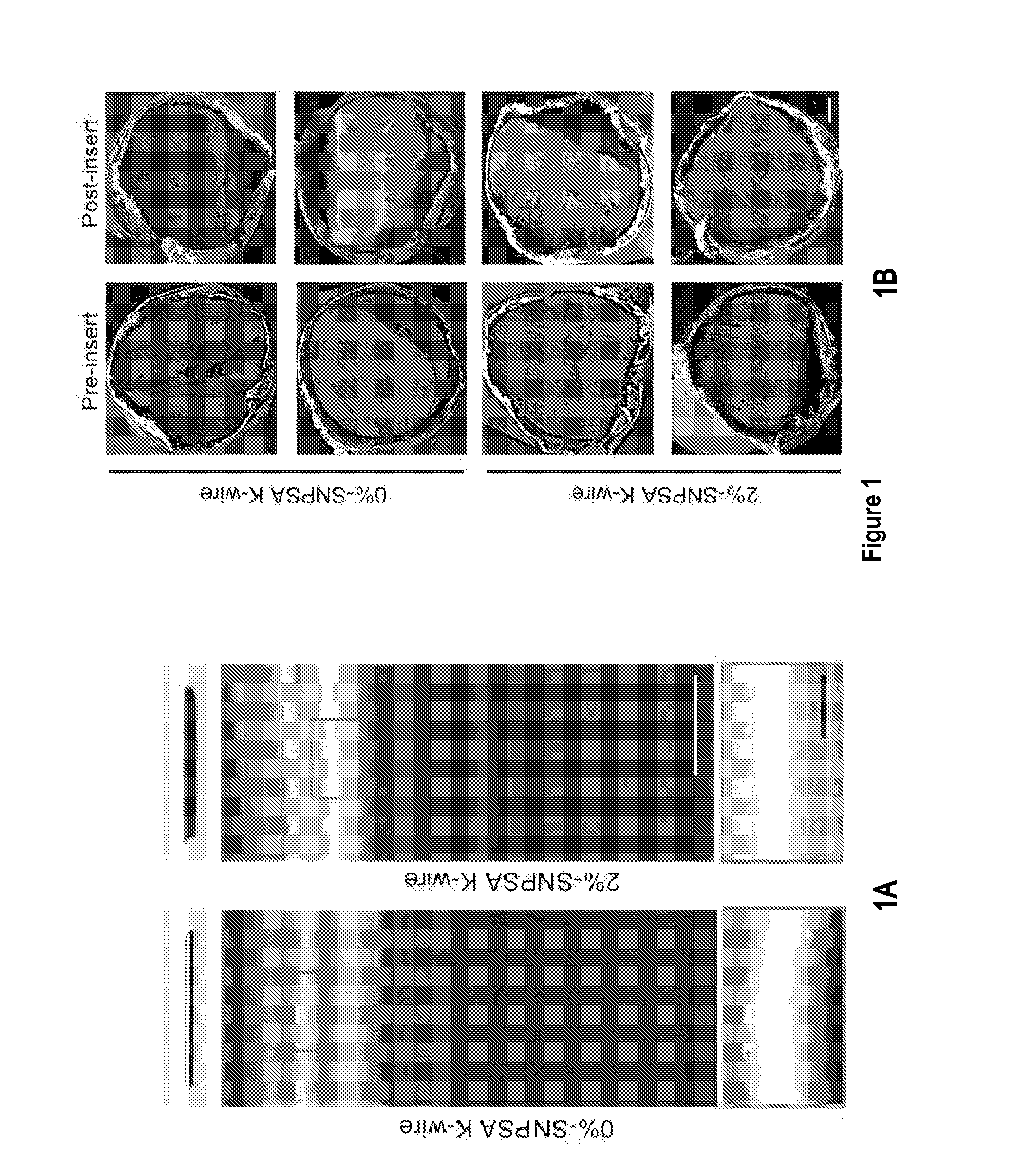Nanoparticle-based scaffolds and implants, methods for making the same, and applications thereof
a nanoparticle and scaffold technology, applied in the field of devices, can solve the problems of significant healthcare and economic burden, increased morbidity and substantially worse outcomes, and insufficient methods for treating such tumors, so as to reduce or eliminate microbial infections, eliminate or reduce a source of microbial infections
- Summary
- Abstract
- Description
- Claims
- Application Information
AI Technical Summary
Benefits of technology
Problems solved by technology
Method used
Image
Examples
example 1
[0121]20-40 nm-diameter spherical silver nanoparticles (QSI-Nano® Silver, QuantumSphere, Inc., Santa Ana, Calif.) were thoroughly mixed with 17.5% (w / v) PLGA (lactic:glycolic=85:15, inherent viscosity: 0.64 dl / g in chloroform; Durect Co., Pelham, Ala.) solution. The proportion of silver nanoparticles refers to the weight ratio of silver nanoparticles to PLGA. 316L stainless steel alloy Kirschner (K)-wire (length: 1 cm, diameter: 0.6 mm; Synthes. Monument, Colo.) and discs (thickness: 1.59 mm, diameter: 6.35 mm; Applied Porous Technologies, Inc., Tariffville, Conn.) were soaked in the silver nanoparticle / PLGA-chloroform solution for 30 s and air-dried completely. The soak-dry process was repeated three times for each SNPSA implant. After incubating for 12 h at 37° C. to ensure a uniform coating, SNPSAs were stored at −20oC until use. Morphology of the SNPSA was evaluated by scanning electron microscopy (SEM; NovaNano SEM 230-D9064, FEI Company, Hillsboro,...
example 2
Surface Free Energy
[0122]Surface free energy of SNPSAs was obtained from contact angle measurements. Contact angles of multiple standard liquids on the tested SNPSAs were measured using a contact angle analyzer (FTA125; First Ten Ångestroms, Portsmouth, Va.). In order to obtain an accurate description of the wetting behavior of various SNPSAs, the surface free energy of the solid (γs), was considered to be the sum of separate dispersion (yd) and non-dispersion (γsnd) contributions. From this two-component model, the following relationship was derived from the dispersion γd and non-dispersion (also known as ‘polar’) γnd interactions between liquids and solids.
γL×(cosθ+1)=2×(γLd×γsd)12+(γLnd×γsnd)12(1)
[0123]Eq. (1), known as the geometric mean model, allows the calculation of the solid surface free energy using the contact angle (θ) and the surface tension components of the standard liquids, where γL, γLd, and γLd represent the surface tension and its dispersion and non-dispersion com...
example 3
In Vitro Antimicrobial Activity
[0124]The Gram-positive vancomycin-intermediate S. aureus (VISA / MRSA) strain Mu50 (ATCC 700699) was cultured in brain heart infusion broth (BHIB; BD, Sparks, Md.) at 37° C.; while biofilm-forming, Gram-negative opportunistic pathogen P. aeruginosa PAO-1 (ATCC 15692) was cultured in Luria Bertani broth (LB; Fisher Scientific, Hampton, N.H.) at 30° C. 103, 104, and 105 colony forming units (CFU) of bacteria were suspended in 1 ml culture broth and incubated with the SNPSA K-wires at 225 rpm on a shaker for 1, 2, 6, and 24 hours.
[0125]At the end of the incubation, Mu50 and PAO-1 bacteria attached to the surface were collected by 0.9% saline solution and plated onto 10-cm BHIB or LB culture medium plates overnight, respectively.
[0126]After 18 h incubation, the number of colonies on each plate was counted and the total viable CFU load was determined.
PUM
| Property | Measurement | Unit |
|---|---|---|
| mean size | aaaaa | aaaaa |
| mean size | aaaaa | aaaaa |
| mean size | aaaaa | aaaaa |
Abstract
Description
Claims
Application Information
 Login to View More
Login to View More - R&D
- Intellectual Property
- Life Sciences
- Materials
- Tech Scout
- Unparalleled Data Quality
- Higher Quality Content
- 60% Fewer Hallucinations
Browse by: Latest US Patents, China's latest patents, Technical Efficacy Thesaurus, Application Domain, Technology Topic, Popular Technical Reports.
© 2025 PatSnap. All rights reserved.Legal|Privacy policy|Modern Slavery Act Transparency Statement|Sitemap|About US| Contact US: help@patsnap.com



